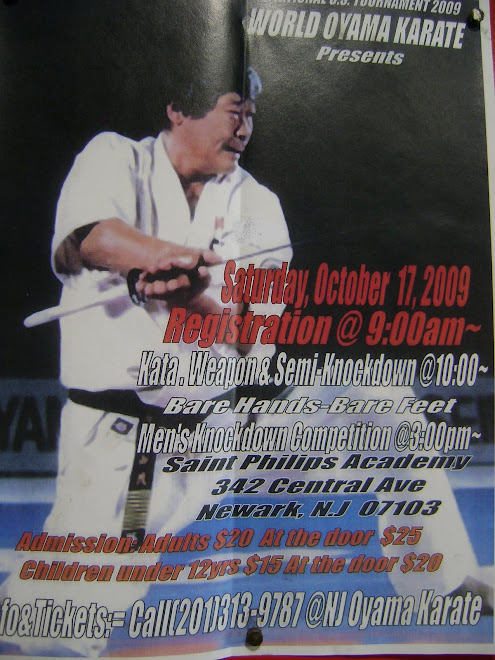Linden Dojo Schedule
MONDAY
12;00pm -Adult Class
5:00pm -Children`s Class /Beginner
6;00pm -Children`s Class /Advanced
7;00pm -Adult Class
WEDNESDAY
12;00pm -Adult Class
5;00pm -Children`s Class /Beginner
6;00pm -Children`s Class/Advanced
7;00pm -Adult Class
FRIDAY
12;00pm -Adult Class
5;00pm -Children`s Class/All-Belts
6;00pm -Children`s Class/Weapons-Class/GREEN-BLACK
7;00pm -Adult Class
SATURDAY
11;00am -Children`s Class/All-Belts
12;00pm -Adult Class
12;00pm -Adult Class
5:00pm -Children`s Class /Beginner
6;00pm -Children`s Class /Advanced
7;00pm -Adult Class
WEDNESDAY
12;00pm -Adult Class
5;00pm -Children`s Class /Beginner
6;00pm -Children`s Class/Advanced
7;00pm -Adult Class
FRIDAY
12;00pm -Adult Class
5;00pm -Children`s Class/All-Belts
6;00pm -Children`s Class/Weapons-Class/GREEN-BLACK
7;00pm -Adult Class
SATURDAY
11;00am -Children`s Class/All-Belts
12;00pm -Adult Class
WORLD OYAMA KARATE is a Classic, Full-contact Japanese style of Karate. In 1965, Mas Oyama, director of the International Kyokushin Organization, sent his chief instructor, Soshu Shigeru Oyama,from Tokyo International headquarters to New York to spread Kyokushin Karate world wide. In 1972, Mas Oyama sent another of his Kyokushin chief instructors from Tokyo, Soshi-Saiko Shihah Yasuhiko Oyama, to Birmingham ,AL to continue the growth of the Kyokushin style. In 1985, the World Oyama Karate Organization was founded as an independent organization. It is directed by Founder Soshu Shigeru Oyama, and Founder Shoshi-Saiko Shihan Yasuhiko Oyama. Over 150 official World Oyama Karate dojos are established in 19 countries. An uncompromising dedication to teaching excellence and well-founded reputation for coaching some of the best international full-contact Karate champions.
Karate is primarily a striking Art using kicking, punching, knee and elbow strikes. Open -handed techniques, locks, restraints, throws and vital point strikes are taught in some styles. A Karate practitioner is called a karateka. Karate can be practiced as budo, as sport, or as self defense training. Traditional karate places emphasis on self development( budo).
Sport Karate places emphasis on exercise and competition. Weapons ( Kobud`o ) is important training activity in some styles. Modern Japanese style training emphasizes the psychological elements incorporated into a proper ``Kokoro ( attitude ) such as Perseverance, Fearlessness, Virtue and leadership skills.
Karate training is commonly divided into ``Kihon ( basics ), ``Kata ( forms ) , and ``Kumite ( sparring ).
To attain a formal rank, the karateka must demonstrate competent performance of Specific Required Kata for that Level.
The Japanese terminology for grades or ranks is commonly used. Requirements for examinations vary among schools .
Kumite is called sparring. It means ``meeting of hands``. Kumite is practiced both as a sport and as self -defense training.
Levels of physical contact during sparring vary considerably. Sport Kumite is free or structured with no -contact or light
contact and Points are awarded by a referee. Full contact karate has several variants.
Knockdown karate usesfull power techniques to bring an opponent to the ground.
Kickboxing variants ( for example K-1 ) win by knockout .Bogu kumite allows full power techniques with some safety. The karateka are allow free choice of punching and kicking techniques. Depending upon style, takedowns and sweeps are allowed...........Osu
Karate is primarily a striking Art using kicking, punching, knee and elbow strikes. Open -handed techniques, locks, restraints, throws and vital point strikes are taught in some styles. A Karate practitioner is called a karateka. Karate can be practiced as budo, as sport, or as self defense training. Traditional karate places emphasis on self development( budo).
Sport Karate places emphasis on exercise and competition. Weapons ( Kobud`o ) is important training activity in some styles. Modern Japanese style training emphasizes the psychological elements incorporated into a proper ``Kokoro ( attitude ) such as Perseverance, Fearlessness, Virtue and leadership skills.
Karate training is commonly divided into ``Kihon ( basics ), ``Kata ( forms ) , and ``Kumite ( sparring ).
To attain a formal rank, the karateka must demonstrate competent performance of Specific Required Kata for that Level.
The Japanese terminology for grades or ranks is commonly used. Requirements for examinations vary among schools .
Kumite is called sparring. It means ``meeting of hands``. Kumite is practiced both as a sport and as self -defense training.
Levels of physical contact during sparring vary considerably. Sport Kumite is free or structured with no -contact or light
contact and Points are awarded by a referee. Full contact karate has several variants.
Knockdown karate usesfull power techniques to bring an opponent to the ground.
Kickboxing variants ( for example K-1 ) win by knockout .Bogu kumite allows full power techniques with some safety. The karateka are allow free choice of punching and kicking techniques. Depending upon style, takedowns and sweeps are allowed...........Osu
Training for 10-9 Kyu
#1.Kihon (basics)
Stances;
Sanchin Dachi, Zenkutsu Dachi/forward stance, Kumite no Tachi/fighting stance /Movement with stances.
Punch and Trust Techniques;
Seiken Tsuki/forefist thrust, Uraken/backfist strike, Seiken Ago Uchi/forefist strike to chin, /Movement with punches and Thrusts.
Kick Techniques;
Hiza Geri /knee kick, Mae Geri /front snap kick, Mawashi Geri /roundhouse kick, Mae Keage /straight leg kick, /Movement with kicking.
#2.Kata (Form Exercise)
Kihon Sono Ichi -movement-separate parts-knowledge of use and purpose of each technique.
#3.Kumite (Free Fighting)
Contact of punches /with Chest guards , arm guards.
Contact of Kick techniques /using chest guards ,arm guards.
Sute Waza /beginning or setup technique ,
Kime Waza /finishing technique /Movement and contact /with and without chest guards.
____________________________________
It takes approximately 3 -4 months to master these techniques.
Stances;
Sanchin Dachi, Zenkutsu Dachi/forward stance, Kumite no Tachi/fighting stance /Movement with stances.
Punch and Trust Techniques;
Seiken Tsuki/forefist thrust, Uraken/backfist strike, Seiken Ago Uchi/forefist strike to chin, /Movement with punches and Thrusts.
Kick Techniques;
Hiza Geri /knee kick, Mae Geri /front snap kick, Mawashi Geri /roundhouse kick, Mae Keage /straight leg kick, /Movement with kicking.
#2.Kata (Form Exercise)
Kihon Sono Ichi -movement-separate parts-knowledge of use and purpose of each technique.
#3.Kumite (Free Fighting)
Contact of punches /with Chest guards , arm guards.
Contact of Kick techniques /using chest guards ,arm guards.
Sute Waza /beginning or setup technique ,
Kime Waza /finishing technique /Movement and contact /with and without chest guards.
____________________________________
It takes approximately 3 -4 months to master these techniques.






